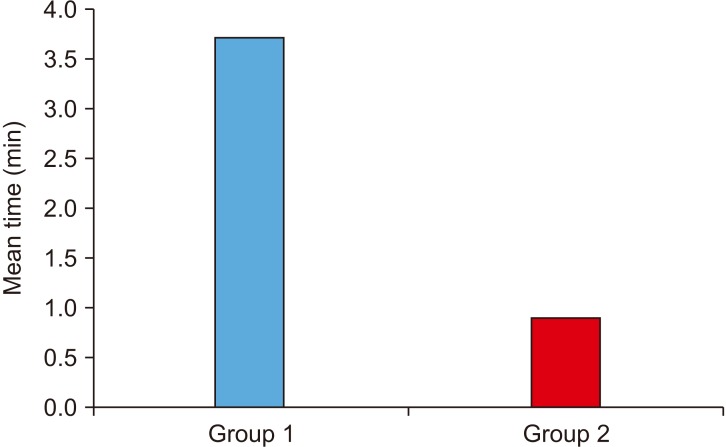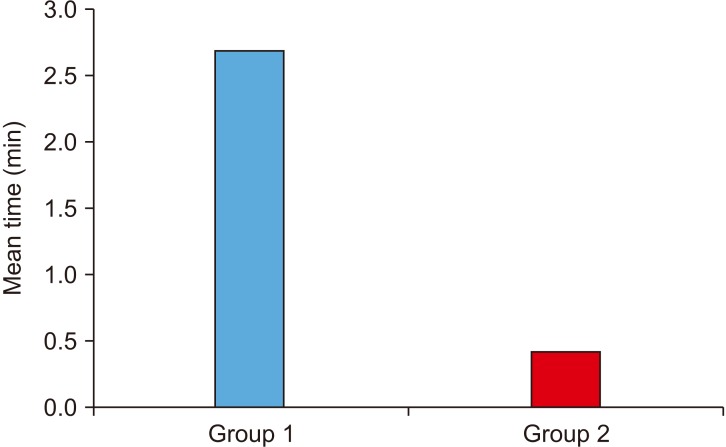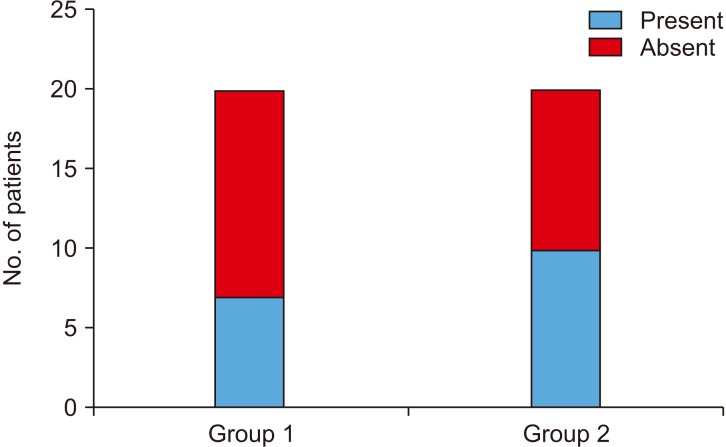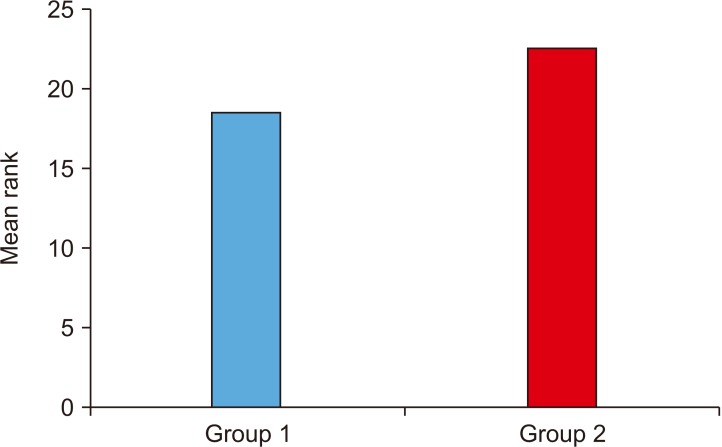J Korean Assoc Oral Maxillofac Surg.
2020 Feb;46(1):28-35. 10.5125/jkaoms.2020.46.1.28.
Comparing intra-oral wound healing after alveoloplasty using silk sutures and n-butyl-2-cyanoacrylate
- Affiliations
-
- 1Department of Oral and Maxillofacial Surgery, Dr. D. Y. Patil Vidyapeeth, Pune, India. sonalbshah@rediffmail.com
- KMID: 2471109
- DOI: http://doi.org/10.5125/jkaoms.2020.46.1.28
Abstract
OBJECTIVES
The need for proper wound closure is of paramount importance after any intra-oral surgery. Various wound closure techniques have been described in literature using traditional non-absorbable suture materials. These include like synthetic absorbable sutures, surgical staples and tissue adhesives. Cyanoacrylates are among the most commonly used biocompatible tissue adhesives. To evaluate and compare intraoral wound healing using 3-0 silk sutures and n-butyl-2-cyanoacrylate after alveoloplasty.
MATERIALS AND METHODS
A total of 20 patients requiring bilateral alveoloplasty in the same arch (upper or lower) were included in this study. Patients with any pre-existing pathology or systemic disease were excluded. After alveoloplasty was performed, the wound was closed using 3-0 braided silk sutures on one side, and using n-butyl-2-cyanoacrylate bio adhesive on the other side. Patients were evaluated based on the following parameters: time required to achieve wound closure; the incidence of immediate and postoperative hemostasis; the time to the use of the first rescue medication; the side where pain first arises; and the side where wound healing begins first.
RESULTS
Compared to 3-0 silk sutures, cyanoacrylate demonstrated better hemostatic properties, reduced operative time, reduced postoperative pain and better wound healing.
CONCLUSION
These data suggest that cyanoacrylate glue is an adequate alternative to conventional sutures to close the surgical wound after alveoloplasty, and better than are 3-0 silk sutures.
MeSH Terms
Figure
Cited by 1 articles
-
Comparative evaluation of the efficacy of wound healing with and without dehydrated human amniotic/chorionic membrane in alveoloplasty: a pilot study
Monica Gajul, Kalyani Bhate, Sayali Awate, Pradnya Kakodkar, Sonal Shah
J Korean Assoc Oral Maxillofac Surg. 2021;47(4):279-285. doi: 10.5125/jkaoms.2021.47.4.279.
Reference
-
1. Kulkarni S, Dodwad V, Chava V. Healing of periodontal flaps when closed with silk sutures and N-butyl cyanoacrylate: a clinical and histological study. Indian J Dent Res. 2007; 18:72–77. PMID: 17502712.
Article2. Kumar MS, Natta S, Shankar G, Reddy SH, Visalakshi D, Seshiah GV. Comparison between silk sutures and cyanoacrylate adhesive in human mucosa: a clinical and histological study. J Int Oral Health. 2013; 5:95–100. PMID: 24324311.3. Kumar VR, Rai AB, Priyayadav . Comparative evaluation of nbutyl cyanoacrylate and silk sutures in intra oral wound closure: a clinical study. J Adv Dent Res. 2010; 1:37–42.4. Setiya S, Halli R, Shah A, Chhabaria G, Singh T. Comparative evaluation of efficacy of tissue glue and sutures after surgical removal of impacted mandibular third molars: a prospective controlled clinical study. J Oral Maxillofac Surg Med Pathol. 2015; 27:183–188.5. Ghoreishian M, Gheisari R, Fayazi M. Tissue adhesive and suturing for closure of the surgical wound after removal of impacted mandibular third molars: a comparative study. Oral Surg Oral Med Oral Pathol Oral Radiol Endod. 2009; 108:e14–e16. PMID: 19464207.
Article6. Joshi AD, Saluja H, Mahindra U, Halli R. A comparative study: efficacy of tissue glue and sutures after impacted mandibular third molar removal. J Maxillofac Oral Surg. 2011; 10:310–315. PMID: 23204746.
Article7. Waite PD, Cherala S. Surgical outcomes for suture-less surgery in 366 impacted third molar patients. J Oral Maxillofac Surg. 2006; 64:669–673. PMID: 16546647.
Article8. Mizrahi B, Weldon C, Kohane DS. Tissue adhesives as active implants. Stud Mechanobiol Tissue Eng Biomater. 2011; 8:39–56.
Article9. Shivamurthy DM, Singh S, Reddy S. Comparison of octyl-2-cyanoacrylate and conventional sutures in facial skin closure. Natl J Maxillofac Surg. 2010; 1:15–19. PMID: 22442543.
Article10. Landry RG, Turnbull RS, Howley T. Effectiveness of benzydamyne HCl in the treatment of periodontal post-surgical patients. Res Clin Forums. 1988; 10:105–118.11. Eaton AC. A controlled trial to evaluate and compare a sutureless skin closure technique (Op-Site skin closure) with conventional skin suturing and clipping in abdominal surgery. Br J Surg. 1980; 67:857–860. PMID: 7004557.
Article12. Singh A, Kohli M, Gupta N. Platelet rich fibrin: a novel approach for osseous regeneration. J Maxillofac Oral Surg. 2012; 11:430–434. PMID: 24293936.
Article13. Petrovsky BV, Gigaury VS, Milonov OB, Perelman MI, Mlinchik VE, Gotye SV, et al. Surgical application of tissue adhesives. World J Surg. 1980; 4:331–336. PMID: 7415186.
Article14. Bhaskar SN. Tissue response of rat tongue to normal and isobutyl cyanoacrylate. Oral Surg Oral Med Oral Pathol. 1968; 26:573–578. PMID: 5244783.15. Morton RJ, Gibson MF, Sloan JP. The use of histoacryl tissue adhesive for the primary closure of scalp wounds. Arch Emerg Med. 1988; 5:110–112. PMID: 3408528.
Article
- Full Text Links
- Actions
-
Cited
- CITED
-
- Close
- Share
- Similar articles
-
- Comparative evaluation of the efficacy of wound healing with and without dehydrated human amniotic/chorionic membrane in alveoloplasty: a pilot study
- Use of the n-butyl cyanoacrylate adhesive and the polyglactine thread suture for corneal rhaphy in rabbit (Oryctolagus cunicullus)
- Multiple Cerebral Infarction after Injection of N-Butyl-2-Cyanoacrylate for Gastric Variceal Bleeding
- Detection of an Infected N-butyl-2-cyanoacrylate Plug by F-18 FDG PET/CT Scan in a Patient Who Received Endoscopic Intervention for Gastric Variceal Bleeding
- A direct tying loop of silk sutures on the electrode





